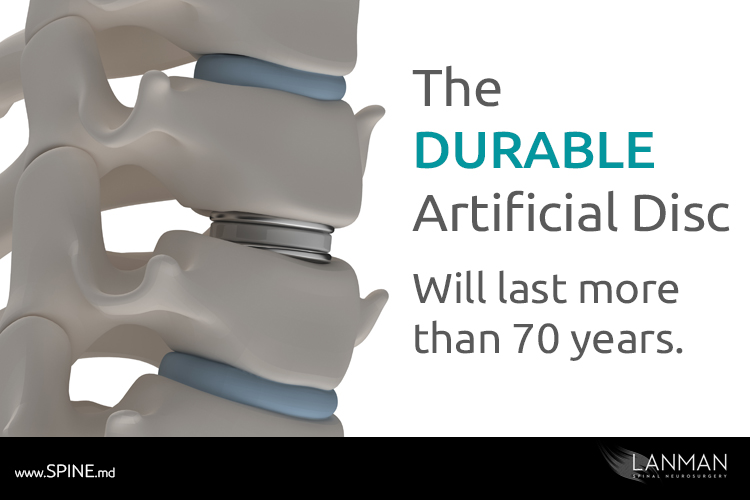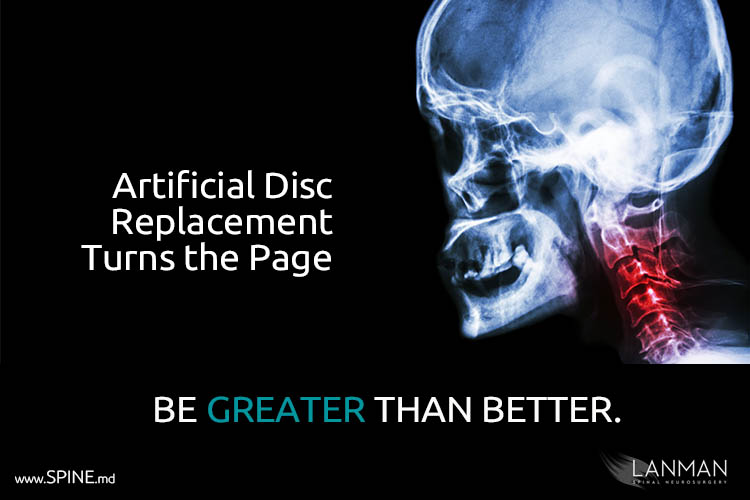When you think of other surgically implanted appliances and devices, obviously, you must consider its durability. Once implanted, how long will it last? When will the patient require corrective or “revision” surgery?
Among all surgically implanted devices, artificial discs have one of the most extended duration cycles—more than 70 years. For most patients, that’s a lifetime. If only other technologies lasted as long. For instance, knee replacements: 10-15 years; hip replacements: 20-25 years.
Advancement of medical technology for these types of implants relies heavily on developments in metallurgy, adaptive biopolymers, and ceramics. In the not-too-distant future, we may see nano-carbon fiber spun implants, lighter and even more durable than metals we currently use. Further in the future, perhaps we’ll see custom-made carbon-plastic implants produced in 3D-print fabrication machines. Today, artificial discs, as a settled medical procedure, is the most extended lasting implant device current technology can provide.
Compared with the titanium and cobalt chrome contraptions surgeons use for spinal fusion, artificial discs are elegant in their simplicity. Spinal fusion requires the addition of what appears to be a metal or plastic cage placed in between two or more vertebrae. We remove the disc material between the vertebrae and screw the bone in a fixed position. To help hold the vertebrae in place, we create a ‘bone graft’ to cause them to ‘fuse’ together. Artificial discs take a different approach. Instead of forced immobility on two vertebrae, we encourage the bones to move freely as they did before. We still must remove old disc material, but now we slip an artificial one in its place. No cage, no bone graft. One last comparison: the two surgeries—fusion and artificial discs—are equally invasive, however, due to the simplicity of artificial discs, recovery is often measured in weeks instead of months.
It is the compound of these factors—durability, simplicity, and adaptability—that makes ADR the cornerstone of Restorative Motion Surgery. I am removing the “cage,” cutting out the bone graft, and adding back in what old medical technology has taken away. This prosthesis often makes it possible.
Based on the results of restorative procedures I have administered to my patients, I’m confident this is where medicine must take us. It is an off-label procedure, not expressly approved by the FDA, however thanks to special rules, surgeons, such as myself, may customize treatment for unique patient situations. I have taken this responsibility in consideration my years of experience as a research clinician, a board-certified neurosurgery specialist practicing medicine, a professor at the University of California Los Angeles, and a member of the Cedars-Sinai Institute of Spinal Disorders. Its development is entirely appropriate. Given the current state of medical technology, even this development should not be called “experimental.”
I am driven by my own personal experiences as a patient of many of the procedures I currently prescribe to my patients. With artificial discs in my neck and in my lower back, I have a very personal relationship with the artificial disc, the procedure, recovery, and the way it has allowed me to carry on my life as much I had before my surgeries. When I think of my own condition, I can visualize the fantastic range of motion of my spine. I know that between the vertebrae are the semi-flexible discs that cushions and limits movement so that I can’t damage the spinal cord and the dozens of tributaries that emanates from the spine.
Each disc and vertebral pair represents what we call a ‘level’ of potential movement. Each level is also wholly independent for movement but dependent on the adjacent pair as pressure, and weight is distributed throughout the chain.
My mission is to release the movement for anyone who wants to restore what they once had, because “movement is life.”







